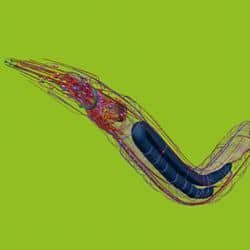Observe that the worm mechanism isn’t significantly worm-like in first glance. Instead of being a wriggling snake like machine, which might pose a great challenge in operating, the OpenWorm team used aadditional standard mechanism on wheels. Thus, behavior is simulated here and not locomotion. OpenWorm has spent a major quantity of time in modeling the worm’s muscles and natural methodology of movement.
OpenWorm uses computer code to do to accurately model each neural association between the 300-odd neurons within the roundworm c. elegans; its aim is to model how data travels through the worm’s body and formulates behavior in its non-brain. The team’s design options a food and proximity device within the front section, that outputs the acceptable signals once stimulated; stimulating the nearby sensor shows the worm that it has encountered an obstacle, inflicting it to prevent moving any further.
Whereas stimulating the food sensor can cause it to maneuver forward. What’s necessary to know is that the researchers didn’t go into the code of the bot to prevent its movement in response to an approaching obstacle. However its design is adopted on the basis of years of evolution and their modeling of that biological programming to similar behavior from the automaton. it’s one amongst the primary samples of emerging automaton whose behavior is supported on novel input and mapped connections, instead of typical, results-focused creating by mental acts. Many intelligent minds are assuming this as the starting of true artificial life, and whereas there’s a kernel of truth thereto, it’s conjointly somewhat dishonest. It’s true therein this is virtually the foremost direct conceive to place the causes and effects of reality into a mechanical type, However that’s not what the event of life was, evolution didn’t realize a nematode worm and plug its brain into the body of a nematode worm, it designed that brain and body from the bottom up, doing exactly the type direct programming this project has abandoned. Simulating a physical brain then hosting that simulation in a very mechanism is probably the smallest economical method of building a brain. This is why the goal of this project was to point out however well they’ve simulated the worm’s brain, to not build a sturdy operating mechanism.
